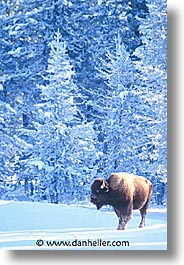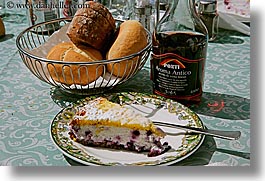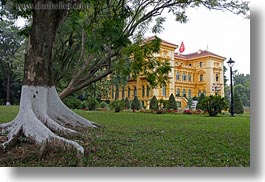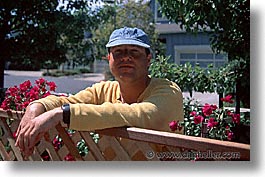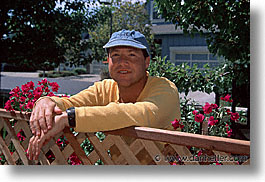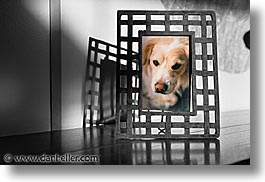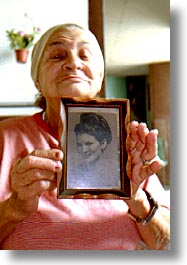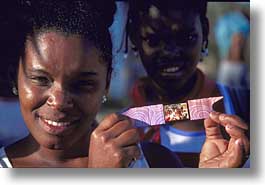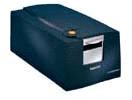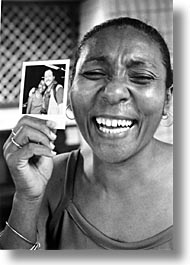|
Markers indicate locations for photos on this page.
Accuracy responsibility of Google Maps
Google Map Goes Here
If you see this text, the map is still loading (or there's an error). |
There are three main technical elements to having a picture come out
well: the proper exposure, the media capturing the light (film or digital
camera), and the way the photo is printed. You may have taken a picture
well, but if you don't use good film, or if it was printed poorly,
then you may still end up with a bad photo. If you have good equipment
and the technical printing is good, but you're still not satisfied, this
could be due two other reasons. On one hand, your expectations may be
way too high. Photos you see in books are often edited in such a way
that make them look far better than they would if the photographer had
merely snapped a picture and instantly printed it. Top photos rarely
look that good right out of the camera, which we'll discuss shortly.
On the other extreme, if you don't like your photos, perhaps it's simply
that you don't take pictures well. But, let's not assume that just yet;
it could be anything at this point, so let's go over all of the reasons.
The thing to realize is that most professional photos you see in books or postcards don't just pop out of the camera like that. More often than not, post-processing is done to an image after it was shot. This isn't necessarily cheating—it's simply how professional photography is done. The reason is that data gathered by a camera is not necessarily the best form to reproduce it in print form, so to make a photo look really good, one has to know those minute idiosyncrasies of both sides of the process ahead of time. For example, some films or digital cameras gather data in darker areas better than lighter areas, which may call for slight exposure compensation when the picture is being shot. Similarly, when the picture is printed, it helps to know what kind of paper and printing process is used, so that the image can be optmized with those materials in mind. If a picture that was shot with only one side of the equasion, it might look pretty bad. Thus, knowing your equipment and how you are going to make prints counts for a lot.
But, let's face it, most people don't know that stuff, nor do they want
to. They just want to take good pictures with fairly automated cameras,
and get good results. In order to do that, more and more automated cameras
and printing devices are produced that meet the "typical" needs of most
consumers, so that most pictures come out pretty well. But, at the higher
end, a lot of those processes end up "watering down" the features found
in professional level processing that makes really good pictures shine.
Hence, the double-edged sword of using automated consumer-level products.
No problem with that—you just need to understand that you're not going
to take those really great pictures you see in books and postcards, unless
you're really lucky.
Ok, let's say you're realistic in your expectations, and you're still
complaining that your prints don't look good. So, let's get to the
question that's really on your mind. It's an automated, fairly expensive
digital camera and you're still getting some bad pictures—it must be the
camera's fault, right? It's easy to blame the camera when your photos
are over- or under-exposed, washed out, unsharp (out of focus), or too
bright from an overly zealous flash. All of these are common complaints
from people who feel they're doing a simple task: pointing the camera at
what they want and clicking the shutter. If it were the camera's fault,
few people would ever take good pictures for this simple reason: almost
all cameras do the same sort of thing. They measure light and capture it
on film (or a digital sensor). This isn't rocket science. If something
is wrong with the camera, no pictures would ever come out well, so if
you're complaining about only a portion of your pictures, chances are
the camera's fine.
Despite the name point-n-shoot, the act of indiscriminantly "pointing and shooting" does not always produce good photos. When pictures look bad, it's often because people think that what they see will simply come out that way in a photo. If it were only that easy. Aside from composition problems, this technique often produces technical errors, such as something throwing off the focus or the light (meter) measurements. There may be a very bright object off to the side, or the middle may be very dark, or it could be that the range of light (from bright to dark) exceeds what the film or digital sensor can reproduce. Other times, the issue is of a different technical nature; the person they are photographing is out of focus, while some object in the background is perfectly sharp. This is especially problematic when photographing two people standing together, or if you put your subject on the side of the frame.
The good news is that correct procedure is almost as simple. Almost all
point-n-shoot cameras have a little green light that illuminates when
you press the shutter button half way. Yes, the shutter button has a
"half-way" point that most people don't know about. When you do this,
the camera focuses on whatever is in the middle of the frame. This is
also where it measures the light for proper exposure. Regardless of how
you want to frame the picture in the end, it's important that you focus
and meter directly on the subject before actually taking the photo.
(If there are two people, focus on just one of them.) When you've
focused on that point, the green light will go on. Now hold that focus
point (by keeping your finger pressing lightly on the shutter button,
thereby keeping the little green light lit), then re-frame the photo
as you want it before completing the button press. This will improve 90%
of your bad pictures. Even better, that long time lag goes away. Once you
have the green-light and are ready to shoot, the instant you press the
shutter button the remaining half-way, the picture will shoot. You'll find
you're not just getting technically better pictures, but you're getting
better compositions as well. (Catching the kid just before plunging into
the pool, for example.)
Speaking of ranges of light, this brings up another important point:
People expect that what they see through the camera is exactly what
they're going to get in print. (Worse, they expect this from other
photographers!) While this may be the case for simple, outdoor daylight
pictures at times, there are other scenes that are more difficult for
one simple reason: your eye can see more light at one time than the
camera can. Put another way, let's rate the darkest light you can
see as "1", and the brightest light you could see as "16". Well,
cameras can only see 5 to 7 of those segments in a single picture. That
is, it can capture the entire range of light, just not at the same time.
This is called, dynamic range. Digital camera sensors (as well as different
film types) all vary in their dynamic range, but a general rule of thumb is
that less expensive digital cameras have a smaller dynamic range.
This makes for another data point in determining what is wrong with those
pictures that you don't like.
The first thing people think of when they think of photography lighting is the flash. But, people often expect too much from what it can do. They don't use it when they should (like in a very bright sunny day), but they expect light to be perfect when shooting at night, which is often the wrong assumption. So, let's review a few things about flashes:
Flashes only light up about 10 feet in front of the camera. Shooting at a dinner table or in a big room, the light from the flash will "fall off" as the distance increases. Don't expect much from taking a photo down a long table, or any sitaution where you want to balance the background and the foreground.
Flashes do nothing for night landscape photography. Don't try taking pictures of your friends in front of the Golden Gate Bridge at night and expect a balanced exposure. The flash will burst the people fine, but the bridge will hardly be visible at all. At night, a proper exposure of the bridge is about 15-30 seconds. Your snapshot at 1/60 of a second won't even touch it.
Don't shoot in front of glass display cases, or through windows.
The flash is only going to bounce off the glass and give you a huge
white light in the photo. Chances are you'll see absolutely nothing
on the other side. Once you know this, it's hilarious to watch people
by the hundreds go to the observations decks of really high buildings,
and take a photo of the gorgeous skyline through a window, flashes
bursting, and knowing that none of those photos will come out. Again,
it requires about 15-30 second exposures to get photos like that to
come out, and the flash has nothing to do with it.
Oddly enough, the best time to use a flash is during the day, to reduce the harsh shadows that you often see under eyes, under hat visors, or in the shade under umbrellas. Use the flash during the day to make more balanced photos. Even at night, a reduced flash power will give better looking pictures.
For a more comprehensive discussion on photographing people and the
use of a flash, see Photographing Native Peoples in Foreign Countries.
While many photo labs are perfectly reasonable at making prints from negatives for the consumer, it is not unusual to find labs that skimp on the process (unintentionally, of course) because (let's be honest), consumer film processing is a time and materials business. The less time and fewer materials you spend, the more cost-effective it is to have the business in the first place. Yes, photo labs will usually reprint photos you're not happy with, but it doesn't necessarily mean you're going to get a good result for certain complicated photos (such as night shots, or oddly lit sunset pictures with broad dynamic range). To make matters worse, even if they did examine individual photos, it requires good judgment to determine a bad print from a good one. It is less likely that one-hour photo lab personnel can do this, even if they had the time or inclination to. Often, the way they print the entire roll is by printing the first one or two photos to see what the general color balance is from there, and then run the rest roll the same way.
"So," you're thinking, "it can't be that hard to make good prints. Someone must be able to do this well." A good option is to look for pro labs that make prints for wedding or portrait photographers, because they use print (negative) film, and the lab must make good prints for them as part of their normal business function. Be forewarned, however: these photo labs are going to charge a lot more than your average drug store and probably take a few days longer. yet, if you're shooting really well with a good camera (and lenses), the difference may just be worth it. Note: Some people think if they send their film to Kodak or Fuji, they'll get the best prints because they are the film companies themselves. Of all people, one might think, they should know how to make good prints. Unfortunately, this rarely turns out to be the case. The only time you should send your film elsewhere for printing is if you have exhausted all options for local labs, and you got a very good recommmendation for an outside lab. Then it becomes a matter of doing research on the internet (which you're already doing if you're reading this). Try going to photo newsgroups or discussion forums, such as http://www.photo.net.
There are alternatives, albeit potentially costly and/or time-consuming, but well worth the effort if you have a little technical expertise. Consider buying a scanner and scanning your film and printing them digitally. Scanners aren't that expensive, and the technical skills in making good prints aren't that difficult, but it does require not having a fear of computers, and you must have a willingness to go through the short, but very steep learning curve. The result is that you can shoot any kind of film, scan your images, and either print them on photo-quality home inkjet printers, or you can give the digital images to any photo lab that can print digital files. That's right any photo lab will do just fine, so long as they have the equipment (and it's likely they do nowadays if you live in a reasonably modern part of the country). With the proliferation of digital cameras these days, most labs can make prints from digital images, and they'll come out exactly the same every time. Whether any given print turns out "good" depends on the nature of the digital file. For consumer-brand digital cameras, there is usually only two things to consider: the resolution setting for the pictures you shot, and the color balance on the digital sensor. For a discussion on this, see What Camera Should I Buy? (Part 2) and Editing, sorting, scanning and archiving slides for a photography business. If you get your digital images from a digital camera, skip this section. If you're scanning your own images, quality will depend on the quality of your scanner and your digital editing skills. This approach requires three things:
As for the expense, a good scanner should run about $1000, and the software ranges from free to $700 or so (if you choose Photoshop, and the printer (about $150 or less for those that give really nice results), but the benefits are worthwhile. That is, a bad print is wasted money, whereas a good print is a good investment. Over time, you'll get more "good prints" that you like that it'll feel worthwhile. What's more, you can put them online, email them to friends, and do lots of other things with them, like do digital art, digital composites, greeting cards, invitations, and the list goes on and on.
I am avoiding making specific recommendations for products because there
are many good options to choose from, and it's the process of learning
about them which will make you good at using them later. You could use
what I use, but that may be overkill for many people. For a discussion
on what I have and how I use it, see Photography Equipment.
Click to recommend this page: |
|
